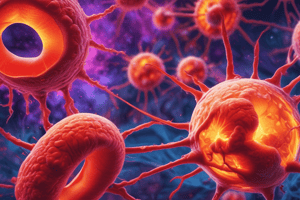Podcast
Questions and Answers
What are the 3 systemic factors that influence healing of the pulp?
What are the 3 systemic factors that influence healing of the pulp?
- Vitamin intake, Sleep quality, Smoking habits
- Allergies, Exercise, Genetic predisposition
- Age, Nutrition, Pre-existing medical conditions (correct)
- Hydration level, Sun exposure, Educational background
How can neutrophils be identified in histology?
How can neutrophils be identified in histology?
- Star-shaped appearance
- Large rounded nuclei
- Long cytoplasmic tails
- Multi-lobed nuclei (correct)
What is a feature that distinguishes reversible pulpitis from irreversible pulpitis?
What is a feature that distinguishes reversible pulpitis from irreversible pulpitis?
- Formation of abscess
- Pain subsides with removal of stimulus (correct)
- Extreme sensitivity to pressure
- Presence of fibrosis
What is a characteristic of open pulpitis?
What is a characteristic of open pulpitis?
Which factor significantly influences the progress of pulpitis and determines its duration?
Which factor significantly influences the progress of pulpitis and determines its duration?
Which of the following is NOT a potential outcome of acute inflammation?
Which of the following is NOT a potential outcome of acute inflammation?
Which of the following is NOT involved in chronic inflammation?
Which of the following is NOT involved in chronic inflammation?
What is the primary cause of an increase in pulpal pressure?
What is the primary cause of an increase in pulpal pressure?
Which of the following is NOT a potential route of microbial access to the pulp chamber?
Which of the following is NOT a potential route of microbial access to the pulp chamber?
What is the correct classification for a pulpitis that is localized, chronic, and infected?
What is the correct classification for a pulpitis that is localized, chronic, and infected?
Which of the following is NOT a feature of neoplasia?
Which of the following is NOT a feature of neoplasia?
What is the primary distinction between benign and malignant tumours?
What is the primary distinction between benign and malignant tumours?
Which of the following cell types can give rise to tumours?
Which of the following cell types can give rise to tumours?
Which of the following is NOT a change in cell growth patterns?
Which of the following is NOT a change in cell growth patterns?
What is the definition of metaplasia?
What is the definition of metaplasia?
What is a potential issue with cancer screening that involves detecting cancer in people who have no signs or symptoms?
What is a potential issue with cancer screening that involves detecting cancer in people who have no signs or symptoms?
What is a major factor affecting the prognosis of a tumor related to the appearance of cells?
What is a major factor affecting the prognosis of a tumor related to the appearance of cells?
In the context of cancer screening, what can lead to unnecessary treatment for conditions that are not harmful or require intervention?
In the context of cancer screening, what can lead to unnecessary treatment for conditions that are not harmful or require intervention?
How do well-differentiated tumors differ from poorly-differentiated tumors in terms of identifying the tissue of origin?
How do well-differentiated tumors differ from poorly-differentiated tumors in terms of identifying the tissue of origin?
What is a key objective observation used in determining the prognosis of a tumor, especially related to its invasive potential?
What is a key objective observation used in determining the prognosis of a tumor, especially related to its invasive potential?
Which of the following is NOT an example of metaplasia?
Which of the following is NOT an example of metaplasia?
What is the primary difference between benign and malignant tumours?
What is the primary difference between benign and malignant tumours?
Which of the following tumours is associated with the lymphoid system?
Which of the following tumours is associated with the lymphoid system?
Which of the following viruses is associated with the development of nasopharyngeal carcinoma and Burkitt's lymphoma?
Which of the following viruses is associated with the development of nasopharyngeal carcinoma and Burkitt's lymphoma?
What is the role of squamous epithelium in the oral mucosa?
What is the role of squamous epithelium in the oral mucosa?
What is the primary mechanism by which HIV initially infects epithelial cells in the first stage of infection?
What is the primary mechanism by which HIV initially infects epithelial cells in the first stage of infection?
How does HIV enter the submucosal epithelium during the second stage of infection?
How does HIV enter the submucosal epithelium during the second stage of infection?
What is the primary mechanism by which HIV enters lymph nodes during the third stage of infection?
What is the primary mechanism by which HIV enters lymph nodes during the third stage of infection?
Which of the following is NOT one of the 7 key stages that occur after HIV binds to a T cell?
Which of the following is NOT one of the 7 key stages that occur after HIV binds to a T cell?
What are the 4 key observations that characterize the acute stage of HIV infection?
What are the 4 key observations that characterize the acute stage of HIV infection?
What are the 3 key observations that characterize the chronic stage of HIV infection?
What are the 3 key observations that characterize the chronic stage of HIV infection?
What occurs after these 5-15 years of HIV infection and what 3 things occur?
What occurs after these 5-15 years of HIV infection and what 3 things occur?
Which of the following is NOT a common symptom of HIV infection?
Which of the following is NOT a common symptom of HIV infection?
What is the primary reason that people with HIV infection become susceptible to opportunistic infections?
What is the primary reason that people with HIV infection become susceptible to opportunistic infections?
What is the mechanism by which HIV is brought into the lymph node in the 3rd stage of infection?
What is the mechanism by which HIV is brought into the lymph node in the 3rd stage of infection?
In HIV infection, what occurs during the 5-15 years stage of infection known as chronic infection?
In HIV infection, what occurs during the 5-15 years stage of infection known as chronic infection?
What is the role of Tat and Rev proteins in HIV infection?
What is the role of Tat and Rev proteins in HIV infection?
During acute HIV infection, what happens to mucosal CD4+ cells?
During acute HIV infection, what happens to mucosal CD4+ cells?
What is the main effect of HIV binding to T cells and entering their nucleus?
What is the main effect of HIV binding to T cells and entering their nucleus?
Why does chronic HIV infection lead to a gradual decline in CD4+ T cells?
Why does chronic HIV infection lead to a gradual decline in CD4+ T cells?
What is the significance of the fusion of viral envelope with the cell membrane in HIV infection?
What is the significance of the fusion of viral envelope with the cell membrane in HIV infection?
What is the main function of reverse transcriptase in HIV infection?
What is the main function of reverse transcriptase in HIV infection?
Why do we see an increase in parasite, bacterial, fungal, and viral infections in HIV patients?
Why do we see an increase in parasite, bacterial, fungal, and viral infections in HIV patients?
How do late proteins translate and assemble in HIV infection?
How do late proteins translate and assemble in HIV infection?
What is the primary mechanism by which HIV enters the submucosal epithelium during the second stage of infection?
What is the primary mechanism by which HIV enters the submucosal epithelium during the second stage of infection?
What are the 4 key observations that characterize the acute stage of HIV infection?
What are the 4 key observations that characterize the acute stage of HIV infection?
What is the primary reason that people with HIV infection become susceptible to opportunistic infections?
What is the primary reason that people with HIV infection become susceptible to opportunistic infections?
What happens to mucosal CD4+ cells during acute HIV infection?
What happens to mucosal CD4+ cells during acute HIV infection?
What are the 3 key observations that characterize the chronic stage of HIV infection?
What are the 3 key observations that characterize the chronic stage of HIV infection?
What is a characteristic feature of embolism?
What is a characteristic feature of embolism?
How do immune complexes arise in endocarditis?
How do immune complexes arise in endocarditis?
What can be indicated by Roth spots in a patient with endocarditis?
What can be indicated by Roth spots in a patient with endocarditis?
Which blood test is conducted and commonly shows a raised WBC count in endocarditis patients?
Which blood test is conducted and commonly shows a raised WBC count in endocarditis patients?
What is the main role of echocardiogram in diagnosing endocarditis?
What is the main role of echocardiogram in diagnosing endocarditis?
Why is blood culture assessment important in choosing bactericidal antibiotics for endocarditis?
Why is blood culture assessment important in choosing bactericidal antibiotics for endocarditis?
What is the significance of a new murmur development in assessing heart disease?
What is the significance of a new murmur development in assessing heart disease?
What is an important condition for considering surgical treatment for endocarditis?
What is an important condition for considering surgical treatment for endocarditis?
What can an electrocardiogram indicate in a patient with endocarditis?
What can an electrocardiogram indicate in a patient with endocarditis?
What investigation should be carried out to diagnose endocarditis if splenomegaly is suspected?
What investigation should be carried out to diagnose endocarditis if splenomegaly is suspected?
Flashcards are hidden until you start studying




